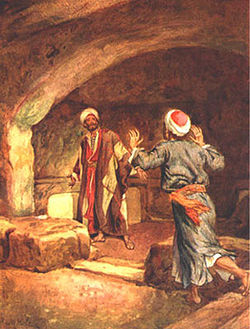
John 20:8
Encyclopedia

Gospel of John
The Gospel According to John , commonly referred to as the Gospel of John or simply John, and often referred to in New Testament scholarship as the Fourth Gospel, is an account of the public ministry of Jesus...
in the Bible
Bible
The Bible refers to any one of the collections of the primary religious texts of Judaism and Christianity. There is no common version of the Bible, as the individual books , their contents and their order vary among denominations...
. Peter
Saint Peter
Saint Peter or Simon Peter was an early Christian leader, who is featured prominently in the New Testament Gospels and the Acts of the Apostles. The son of John or of Jonah and from the village of Bethsaida in the province of Galilee, his brother Andrew was also an apostle...
and the Beloved Disciple are examining Jesus
Jesus
Jesus of Nazareth , commonly referred to as Jesus Christ or simply as Jesus or Christ, is the central figure of Christianity...
's empty tomb
Empty tomb
Empty tomb most often refers to the tomb of Jesus which was found to be empty by the women who were present at Jesus’ crucifixion. They had come to his tomb to anoint his body with spices...
. Peter has been inside the tomb since John 20:6
John 20:6
John 20:6 is the sixth verse of the twentieth chapter of the Gospel of John in the Bible. Peter and the Beloved Disciple have just arrived at the empty tomb of Jesus. The Beloved Disciple, who arrived slightly ahead of Peter, paused outside the empty tomb...
, while the Beloved Disciple had been examining it from outside. In this verse the Beloved Disciple enters the tomb.
In the King James Version of the Bible the text reads:
- Then went in also that
- other disciple, which
- came first to the sepulchre,
- and he saw, and believed.
The World English Bible
World English Bible
The World English Bible is a public domain translation of the Bible that is currently in draft form. Work on the World English Bible began in 1997 and was known as the American Standard Version 1997...
translates the passage as:
- So then the other disciple
- who came first to the
- tomb also entered in, and
- he saw and believed.
The central debate over this verse is what exactly the Beloved Disciple believed. The earlier verses mention only Jesus' grave clothes as being in the tomb. The debate is whether the Beloved Disciple could have come to believe in the resurrection based on such minimal evidence. If he did suddenly understand what had happened, why did he not share this understanding with Peter, or with Mary Magdalene
Mary Magdalene
Mary Magdalene was one of Jesus' most celebrated disciples, and the most important woman disciple in the movement of Jesus. Jesus cleansed her of "seven demons", conventionally interpreted as referring to complex illnesses...
who is also believed to be present? Why, after this revelation, does the Beloved Disciple simply leave to go home in John 20:10
John 20:10
John 20:10 is the tenth verse of the twentieth chapter of the Gospel of John. Peter and the Beloved Disciple have just finished examining the empty tomb of Jesus and in this verse return home....
? A long line of scholars including Saint Augustine
Augustine of Hippo
Augustine of Hippo , also known as Augustine, St. Augustine, St. Austin, St. Augoustinos, Blessed Augustine, or St. Augustine the Blessed, was Bishop of Hippo Regius . He was a Latin-speaking philosopher and theologian who lived in the Roman Africa Province...
have thus argued that the Beloved Disciple simply came to believe Mary Magdalene's story that the body was gone.
The majority of scholars believe that this passage indicates the Beloved Disciple became aware of the resurrection albeit with limited understanding. Calvin said, "it is a poor exposition which some people give of these words, that John believed what he heard Mary say namely, that Christ's body had been carried away; there is no passage in which the word 'believe' carries this meaning, especially when it is used simply and on its own". Leonard argues that the fact that the grave clothes were left carefully in place clearly indicated that the body had not been stolen, and instead showed that Jesus had been resurrected. Bultmann believes that Peter had already realized what had happened, and in this passage the Beloved Disciple merely joins Peter in this understanding. Bruce disagrees, arguing the scripture implies that Peter remained ignorant. Luke 24:12 has Peter leaving the scene "wondering what had happened". Most scholars who read the verse as indicating that the Beloved Disciple understood the resurrection believe that he was the first person to reach this understanding.
Schnackenberg takes a third approach. He argues that this passage does intend to report that Beloved Disciple understood the resurrection, but that the verse was a later addition to the text. This theory would explain why the verse does not mesh well with the rest of the narrative. The realization of the Beloved Disciple, despite its seeming importance, is not again mentioned in the narrative.

